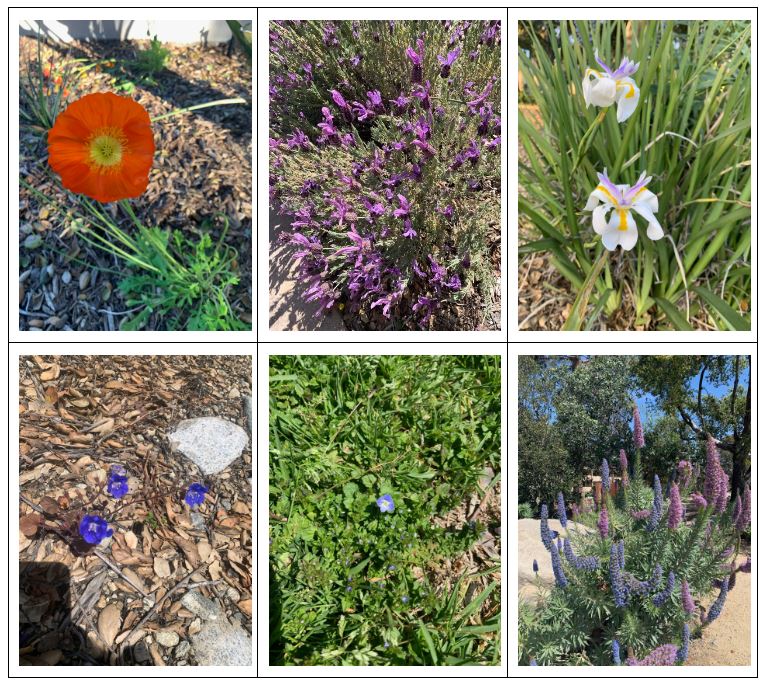Topped Lavender and Sowthistle: A reflection on my experience at Mudd
April 14, 2023
As I was walking around campus this week, I spent a few moments interacting with the flora of Mudd. In contrast to the blocky architecture that forms the foundation of the Mudd visual experience, Mudd is covered with a variety of plants. From flowers to succulent plants to trees, the flora of Mudd reaches out to students, beckoning them to spare a few moments to recognize their beauty.

For especially intriguing flowers, I took pictures of them and used a plant app to learn more about them. I discovered a variety of plants around campus: bright Iceland poppies, ethereal Fairy irises, vibrant topped lavender, captivating California bluebells, tiny Birdeye speedwells, and stunning Pride of Madeira (see each flower starting from the top left in the above table). What interested me the most, however, was a small yellow flower blooming fiercely under a plot of topped Lavender in front of the HMC café. This small flower was a common sowthistle. It contrasted with the deep purple magenta of the topped lavender, seeming to foreshadow its symbolic difference from the other flower.
In understanding the cultural and symbolic significance of the lavender flower and sowthistle, I began to connect my own experiences at Mudd to the ideas each flower represents. According to 1-800 Flowers, Lavender flowers represent “purity, silence, devotion, serenity, grace, and calmness” (Maffia). This reminded me of my experiences in the library at Mudd during exam season. There is a quiet devotion to one’s studies, a sort of purity in the silence of students studying intently. Should one be able to fully appreciate the soft symphony of rustling papers, keyboard taps, and the padding walks of students, one could experience a level of serenity. At least, if the stress of the assignment one is studying for does not overshadow this unique experience. And speaking from experience, it usually does. But if you are lucky enough to pause to enjoy the experience, I believe you won’t regret it. Yet, beautifully, my experiences at Mudd don’t end with the “serenity, grace, and calmness” found in the lavender flower. I couldn’t find much on the flower meaning of the common sowthistle, so I looked into the meaning of the thistle instead. Though a sow thistle is scientifically classified as a Sonchus, and the thistle a Cirsium, both belong under the biological genera of the thistle.

According to Symbol Sage, thistles represent “overcoming adversity and difficult situations” as well as ”devotion, bravery, determination, and strength.” They are “a symbol of resilience” (Rhys). I found this to be incredibly fitting, especially as it bloomed under the serenity and grace of the topped lavender. This reminded me of my overall experience at Mudd. Underneath the serenity I should feel after attending a college that I have found to be perfect for me, is a reminder of the variety of adversities I had to overcome in my transition to Mudd. On paper, it was easy to focus on the great aspects of Mudd – the supportive community, devoted professors, spaces for creativity, even food I liked to eat. However, Mudd required me to evaluate and change my relationship with academics. I needed to learn how to learn, how to ask for help, and how to push past academic insecurities. Personally, I felt a deep frustration when I could not figure out a particular concept. It turns out that the source of my frustration was my fear of asking for help because I would be acknowledging an academic shortcoming. So I learned to ask for help. I learned how to lean on others and then support myself when needed. This was not an easy process, but I am able to write this blog post today due to the determination, strength, and resilience of my past actions. I find the sowthistle to be much more beautiful because of this.
I am grateful to Mudd for planting these two flowers side by side, or, at least, providing the opportunity for them to grow in this way. Their connection has allowed me to reflect on some of my Mudd experiences. Expanding this, one could not truly appreciate the beautiful serenity in enjoying certain aspects of Mudd without acknowledging the determination and strength of students attending the college. I hope that this reflection will be beneficial to you, the reader, in some way. Maybe you will take your own walk around Mudd, or wherever you currently reside, and find a connection in the flora around you.
Happy Spring 🙂

Sources
Maffia, Nancy. “Lavender Meaning: History, Symbolism, & Facts | Petal Talk.” 1-800-Flowers.com. Accessed 30 March 2023.
Rhys, Dani. “Thistle Flower – Symbolism and Meaning.” Symbol Sage. Accessed 30 March 2023.